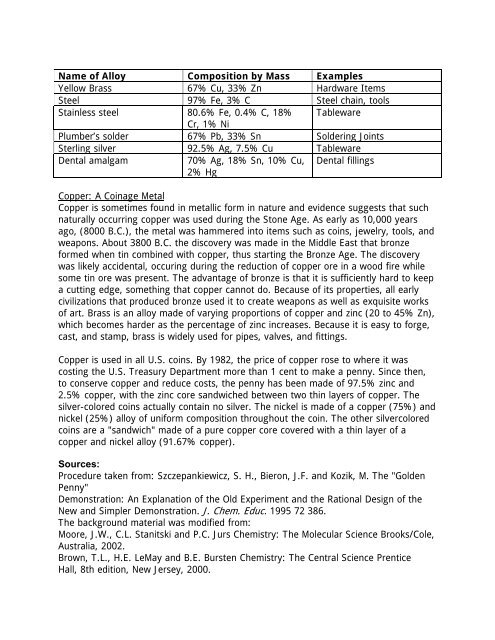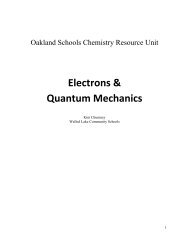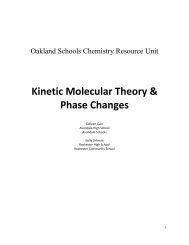Create successful ePaper yourself
Turn your PDF publications into a flip-book with our unique Google optimized e-Paper software.
Name of Alloy Composition by Mass Examples<br />
Yellow Brass 67% Cu, 33% Zn Hardware Items<br />
Steel 97% Fe, 3% C Steel chain, tools<br />
Stainless steel 80.6% Fe, 0.4% C, 18% Tableware<br />
Cr, 1% Ni<br />
Plumber’s solder 67% Pb, 33% Sn Soldering Joints<br />
Sterling silver 92.5% Ag, 7.5% Cu Tableware<br />
Dental amalgam<br />
70% Ag, 18% Sn, 10% Cu,<br />
2% Hg<br />
Dental fillings<br />
Copper: A Coinage Metal<br />
Copper is sometimes found in metallic form in nature and evidence suggests that such<br />
naturally occurring copper was used during the Stone Age. As early as 10,000 years<br />
ago, (8000 B.C.), the metal was hammered into items such as coins, jewelry, tools, and<br />
weapons. About 3800 B.C. the discovery was made in the Middle East that bronze<br />
formed when tin combined with copper, thus starting the Bronze Age. The discovery<br />
was likely accidental, occuring during the reduction of copper ore in a wood fire while<br />
some tin ore was present. The advantage of bronze is that it is sufficiently hard to keep<br />
a cutting edge, something that copper cannot do. Because of its properties, all early<br />
civilizations that produced bronze used it to create weapons as well as exquisite works<br />
of art. Brass is an alloy made of varying proportions of copper and zinc (20 to 45% Zn),<br />
which becomes harder as the percentage of zinc increases. Because it is easy to forge,<br />
cast, and stamp, brass is widely used for pipes, valves, and fittings.<br />
Copper is used in all U.S. coins. By 1982, the price of copper rose to where it was<br />
costing the U.S. Treasury Department more than 1 cent to make a penny. Since then,<br />
to conserve copper and reduce costs, the penny has been made of 97.5% zinc and<br />
2.5% copper, with the zinc core sandwiched between two thin layers of copper. The<br />
silver-colored coins actually contain no silver. The nickel is made of a copper (75%) and<br />
nickel (25%) alloy of uniform composition throughout the coin. The other silvercolored<br />
coins are a "sandwich" made of a pure copper core covered with a thin layer of a<br />
copper and nickel alloy (91.67% copper).<br />
Sources:<br />
Procedure taken from: Szczepankiewicz, S. H., Bieron, J.F. and Kozik, M. The "Golden<br />
Penny"<br />
Demonstration: An Explanation of the Old Experiment and the Rational Design of the<br />
New and Simpler Demonstration. J. Chem. Educ. 1995 72 386.<br />
The background material was modified from:<br />
Moore, J.W., C.L. Stanitski and P.C. Jurs Chemistry: The Molecular Science Brooks/Cole,<br />
Australia, 2002.<br />
Brown, T.L., H.E. LeMay and B.E. Bursten Chemistry: The Central Science Prentice<br />
Hall, 8th edition, New Jersey, 2000.
















